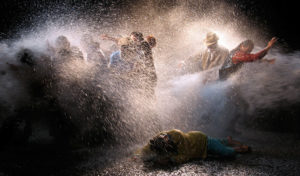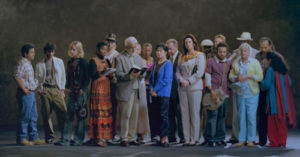 I went to the J Street conference in Washington over the weekend. An interesting time was had by all. There were plenty of denunciations of Trump and Netanyahu, talk of resistance, plenty of interesting speakers, including several members of Knesset, US senators (Chris Murphy, Tim Kaine, Bernie Sanders), prominent Palestinians, diplomats, journalists, big machers from the American Jewish community, the whole ball of wax. There were a lot of enthusiastic young people, along with a fair number of curdled and cynical old timers like myself, old enough to have seen too many dreams smashed too often to hold out much hope, though I try to rain only on my parade and not the parades of others.
I went to the J Street conference in Washington over the weekend. An interesting time was had by all. There were plenty of denunciations of Trump and Netanyahu, talk of resistance, plenty of interesting speakers, including several members of Knesset, US senators (Chris Murphy, Tim Kaine, Bernie Sanders), prominent Palestinians, diplomats, journalists, big machers from the American Jewish community, the whole ball of wax. There were a lot of enthusiastic young people, along with a fair number of curdled and cynical old timers like myself, old enough to have seen too many dreams smashed too often to hold out much hope, though I try to rain only on my parade and not the parades of others.
Fear was pervasive. A fear of being out of power, a fear of not knowing what comes next, and it was a fear of Trump, not Netanyahu, that predominated. And since there is general and genuine uncertainty about Trump’s Israel policy, for many there was a confusion about what strategy and tactics to adopt. In addition, there was a gnawing sense that, despite the transcendental importance of the Israel and Palestine issue, American Jewish peace activists and American peace activists in general, will have their hands full dealing with domestic problems, and will not be able to give the full measure of their moral outrage to the Israel Palestine situation.
The conference was very well attended, perhaps too well attended, since there were too many people crowding into rooms that were too small, and things got a bit hot and sticky, and a too—what is the right word?—too intimate. Anyway, I was feeling a little claustrophobic, I decided I needed a little air. So I took advantage of being, for a change, in a real city, walked a few blocks, and found myself in front of the National Portrait Gallery, and went in for a look. They told me at the desk that the presidential portrait gallery was closed for the day. I told them that I wasn’t much in the mood to look at portraits of presidents anyway. There was much else to see besides.
 Eventually, I got to an exhibit of a veteran video artist named Bill Viola. I wasn’t too familiar with his work. I watched a ten minute video called “The Raft.” Here’s the set-up. There are 19 people, mixed in age, sex, class, and race, standing around, with only a minimal amount of interaction, like a crowd of people waiting for a bus or train. There’s no talking, just some background noise. Then about five minutes into the film, water starts pooling on the ground. Then, suddenly, incredibly powerful blasts of water, as from a fire hose at very close distance, first from one direction and then the other, knocked everyone off their feet. The water blasts last for a few minutes, and then cease. Some people are prostrate, others have embraced one another, helping the other from falling. Some people are weeping. Some of the stronger looking people start helping the others up. The video ends. I have attached a partial version of “The Raft” that begins when the water starts.
Eventually, I got to an exhibit of a veteran video artist named Bill Viola. I wasn’t too familiar with his work. I watched a ten minute video called “The Raft.” Here’s the set-up. There are 19 people, mixed in age, sex, class, and race, standing around, with only a minimal amount of interaction, like a crowd of people waiting for a bus or train. There’s no talking, just some background noise. Then about five minutes into the film, water starts pooling on the ground. Then, suddenly, incredibly powerful blasts of water, as from a fire hose at very close distance, first from one direction and then the other, knocked everyone off their feet. The water blasts last for a few minutes, and then cease. Some people are prostrate, others have embraced one another, helping the other from falling. Some people are weeping. Some of the stronger looking people start helping the others up. The video ends. I have attached a partial version of “The Raft” that begins when the water starts.
“The Raft” in its title, invokes Théodore Géricault’s Romantic era masterpiece, “The Raft of the Medusa” a depiction of shipwrecked survivors clinging to life on a raft. Water gives life, water can kill. It depends on what you do with it. Viola’s “The Raft” was made in 2004, and, if, perhaps, 9/11 was its immediate inspiration, viewers are free to apply to any catastrophe of their choice. I thought of Trump, and I thought of the occupation. Most of us, most of the time, are like the people in the opening of the video; minding our own business, waiting for a bus, waiting for the day to begin, not really interacting with our neighbors. It takes a disaster to pierce our anonymity, to make us pay attention to those living their lives in our midst. And then, we become helpful, we reach out, we try to understand the situation of others. This is the case in the United States today—we must not be bystanders to oppression, not of immigrants from Mexico, refugees from Syria, Bedouins in the Negev, Palestinians in Gaza. And the reason we must not be bystanders is that we are in this together. Unless we save others from the rising water, we will be submerged. There never has been a falser dichotomy than that posed by our president, love of country vs. love of the world.
All the speeches I heard at the J Street conference, all the old and new friends I met were great, but in some ways they all said things I already knew. Great works of art cut to the chase and make their points by reminding you of the power of obvious truths. For me, the highlight of the J Street conference was “The Raft.”
As I left the exhibit, I was trying to remember the famous closing lines of T.S. Eliot’s “The Love Song of J. Alfred Prufrock. Here they are:
We have lingered in the chambers of the sea
By sea-girls wreathed with seaweed red and brown
Till human voices wake us, and we drown.
No, I said to myself, Eliot was a very smart man (for a vicious Antisemite, but let me not get distracted), but he was often wrong. No, it is only when human voices wake us, that we are able to stay afloat, and find a spot on the raft.